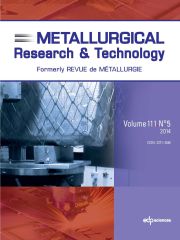Article contents
Tools for continuous improvement of the plate quenching process*
Published online by Cambridge University Press: 19 December 2011
Abstract
Over the past few years several technical efforts have been focused on continuous improvement of quench and tempered product at ArcelorMittal Burns Harbor plate mill facility with particular attention being given to optimization of the flatness of quenched product. Incremental improvement in quench line equipment and practices is being aided by computer-based modelling tools and specialized instrumentation. The paper describes the development of different tools used to control flatness after quench and tempering units. The detailed description of a 3D model designed to predict distortion such as edge waves, center buckles, longbows and crossbows during quenching is presented. The model developed with Abaqus is able to predict the evolution of plate temperature, thermal stresses, strains, and distortions during cooling. The water cooling system is represented by top and bottom movable surfaces where a heat flux depending on width, length and temperature is applied. The effect of phase transformation is approximated by a variation of the plate thermal expansion coefficient.
Keywords
- Type
- Research Article
- Information
- Copyright
- © EDP Sciences, 2011
References
- 1
- Cited by


